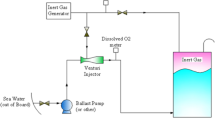Abstract
To evaluate the corrosivity of seawater, the SWRO (Sea Water Reverse Osmosis) produced water, and the community tap water were used in this study. Weight loss method and potentiodynamic polarization test were applied to compare the corrosivity between them. Coupons and pipes for the experiments were prepared with the same materials such as carbon steel, zinc, copper, and STS304 achieved in equivalent condition. As a result of experiments, seawater showed constituent ions such as Cl−, SO4 2−, Mg2+, and Ca2+ (in order of abundance), while the SWRO produced water showed lower pH, calcium hardness and alkalinity than the tap water. Since chloride ion, as an acceleration factor of corrosion, was highly detected, the test results of weight loss method and potentiodynamic polarization indicated that release of metal ions and weigh loss were more abundant in the SWRO membrane desalted permeate than in the tap water. Besides, corrosion potential was also lower in SWRO membrane desalted permeate. It represents that the surface of metal could be exposed easily to oxidize in SWRO condition due to low dissolved alkali metal ion of water.
Similar content being viewed by others
References
Jang, Y. W. (2010). “Effect of specimen area and measurement technique on the corrosion rate of low alloy steel.” Journal of Korean Electrochemical Society, Vol. 13. No. 2, pp. 96–102.
Jo, K. H., Kim, S. H., and Woo, D. S. (2007). “Effects of pH, alkalinity, chloride on the copper pipe corrosion.” Journal of Korean Society Of Environmental Health, Vol. 33, No. 1, pp. 43–48.
Kim, C. H. (2000). A reverse osmosis desalination system, Academy Book (Seoul), pp. 14–17.
Kim, I. S. (2002). Study on a magnetic field effect for acidic film for carbon steel pipe, Report on Korea Institute of Nuclear Safety, pp. 5–19.
Kim, I. S. and Oh, B. S. (2008). “Technologies of seawater desalination and wastewater reuse for solving water shortage.” Journal of Korean Society of Environmental Engineers, Vol. 30 No. 12, pp. 1197–1202.
Kuh, S. E., Woo, D. S., Lee, D. J., Kim, J. W., Ahn, H. W., and Moon, K. S. (2006). “Internal corrosion control of drinking water pipes by PH and alkalinity control and corrosion inhibitor.” Journal of the Korean Society of Water and Wastewater, Vol. 20. No. 2, pp. 215–223.
Kwak, P. J., Lee, H. D., Nam, S. H., and Chung, W. S (2001). “The characteristic properties of corrosivity and metal release on water quality with water resources.” Journal of Korean Society of Environmental Engineers, Vol. 23 No. 7, pp. 1195–1203.
Lee, D. J., Kim, Y. I., and park, H. A. (2008). “Corrosion control in water distribution system using lime and carbon dioxide (2) — Evaluation on the characteristics of corrosion as a function of pipe material.” Journal of the Korean Society of Water and Wastewater, Vol. 22, No. 3, pp. 379–388.
Marangou, V. A. and Savvides, K. (2001). “First desalination plant in Cyprus product water aggresivity and corrosion control.” Desalination, Vol. 138, Nos. 1–3, pp. 251–258.
Nam, S. H. (2002). Water quality characteristics of tap water and management status of corrosion inhibitor, International Workshop of Corrosion Inhibitor for Tap Water Uses, pp. 3–32.
Shon, B. Y., Byun, K. S., Kim, Y. I., and Lee, D. J. (2008). “Corrosion control in water distribution system using lime and carbon dioxide (1) — Determination of optimum operational conditions in lime adding process.” Journal of the Korean Society of Water and Wastewater, Vol. 22, No. 3, pp. 373–378.
Woo, D. S. and Hwang, B. G. (2008). “A study on the corrosion characteristics of carbon steel pipes by phosphate corrosion inhibitor.” The Korean Academia-Industrial Cooperation Society, The Korean Academia-Industrial Cooperation Society, Vol. 9, No. 2, pp. 493–499.
Author information
Authors and Affiliations
Corresponding author
Rights and permissions
About this article
Cite this article
Woo, DS., Hwang, BG. Corrosivity evaluation of SWRO membrane desalted permeate. KSCE J Civ Eng 18, 53–59 (2014). https://doi.org/10.1007/s12205-014-0161-7
Received:
Revised:
Accepted:
Published:
Issue Date:
DOI: https://doi.org/10.1007/s12205-014-0161-7




